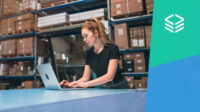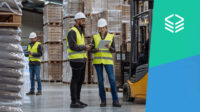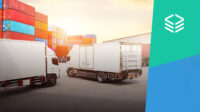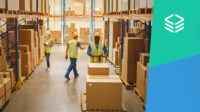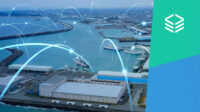Thanks to technology and the rise of ecommerce, immediacy is part of our cultural norm. Consumers want their shipments delivered almost as quickly as the time it takes to place their orders. Because of the uptick in consumer demand, companies struggle with maintaining same-day, last mile logistics. Let’s explore the definition of last mile logistics, associated costs, and the changing consumer trends affecting the industry.
What Is Last Mile Logistics?
As the term indicates, last mile logistics refers to the final point at which a package arrives at a customer’s front door. Though there are several points before that delivery, last mile logistics is the most time-consuming and expensive part of the shipping process. The problem is inefficiency.
The final leg of shipment includes various stops with low delivery sizes, depending on other deliveries being made in the area. Long distances between delivery drops, traffic congestion, and other delays can increase the window for delivery times. Since customers can track their packages through a personalized code or link, they can see when their goods are delayed. When they receive their packages later than anticipated, customer satisfaction quickly begins to decline.
Unfortunately, problems with last mile logistics only continue to grow as customer expectations have risen. The current consumer demand is at the point where same day delivery or, at the very least, two-day home delivery is the rule, not the exception. Furthermore, with the surge of online shoppers, more people are ordering products online to be delivered at the customer’s doorstep.
This puts stress on the fulfillment service provider and delivery process as the number of deliveries waiting to be made outnumbers the drivers available to handle the increasing load. In fact, it’s been reported the U.S. is facing a truck driver shortage by 80,000 drivers, which means the people responsible for the last mile delivery are severely short-staffed.
Costs Associated with Last Mile Logistics
The final leg of delivery accounts for 53% of overall shipping costs. And with the availability of free shipping included from more ecommerce stores, paying extra for a delivery fee isn’t something customers are willing to do, which means this cost and responsibility is shouldered by the retailers and their logistics providers. However, partnering with a fulfillment company with built-in technology solutions can help provide more accurate inventory forecasting and limit these shipping costs.
At Flowspace, our network optimization algorithm identifies the closest fulfillment centers from our network of warehouses to enable fast, affordable shipping for your customers. It helps determine how to best allocate inventory based on where your customers are located. And our picking, packing, and shipping services orders are to your exact specifications for an optimal customer experience.
The growing demand for customers who expect same-day or next-day delivery without additional cost is causing retailers to pivot their last mile fulfillment strategy to stay competitive. 46% of consumers expect next-day delivery to be free with 81% unwilling to pay more than $5 for same day delivery. Ultimately, speedy fulfillment is no longer a competitive advantage, but rather an expectation for every online shopping and delivery experience. Without it, consumers are quick to find a retailer that can fulfill their needs quicker.
Consumer Trends Affecting Last Mile Logistics
Optimizing last mile logistics starts with answering the demand of consumer trends. Businesses that work with a reliable fulfillment company and implement these solutions will have better success maintaining customer satisfaction.
1. Rapid Order Fulfillment
Consumers want their products delivered as fast as possible, if not sooner, and will pay premium pricing to receive them. Millennial consumers make up the demographic of most digital buyers and say they’ll pay up to 30% for same-day delivery. While this could offset some of the logistical costs taken on by retailers and their fulfillment partners, the increasing number of people who want same-day or next-day delivery will continue to be challenging for retailers to meet the demand.
2. Smart Technology
Smart technology will continue to impact final mile logistics when tracking packages. Sensors and GPS data can track drivers street-by-street to see shipments delivered in real-time. Both shippers and consumers can receive alerts regarding the estimated time of arrival and notifications with images of deliveries made to the customer’s doorstep. This functionality and these features will only continue to become more sophisticated, allowing people to see their deliveries be made even without in-person contact.
3. Anticipatory Shipping
Social media already delivers ads for products it thinks we’ll be interested in based on demographic targeting. This strengthens the idea of anticipatory shipping, which will predict, pack, and ship products that are expected to be purchased soon by customers based on their previous buying behavior. Like an AI personal shopper, anticipatory shipping can mean customers will receive shipments of things they’ve yet to buy with the expectation they’ll want to purchase.
4. Increasing City Warehouses
Increasing the number of warehouses and fulfillment centers in major cities can help speed up last mile logistics and provide customers the same-day delivery they want and expect. Fulfillment companies are investing in increasing the number of warehouse locations in areas with a high number of deliveries. They are also diversifying their locations to span across the country to minimize supply chain disruptions due to weather, surging demand, and other common scenarios. At Flowspace, we implement our network optimization algorithm to choose the warehouse closest to your customer base to meet their delivery requirements and uphold customer satisfaction.
5. Integration and Automation
Part of optimizing last mile logistics starts with partnering with a fulfillment network that integrates all parts of supply chain management to adapt quickly to supply and demand ebbs and flows. At Flowspace, our ecommerce fulfillment solutions integrate all storefronts, shopping carts, and marketplaces with a one-click setup. Having data centralized in one place allows businesses to prioritize their pipeline inventory and decide delivery requirements based on different classifications. It helps to strategize which products qualify for same-day or next-day delivery and which may not be as high on the priority list.
Additionally, industry trends including automation and crowdsourcing could increase the number of drone deliveries, self-driving cars, and increase the likelihood of partnering with delivery drivers by region to ensure pickup and delivery is made in a timely way. In the end, the customer doesn’t know the steps it takes to their doorstep. If it’s early or on time expectations are met, but a single delay puts businesses at risk of losing customer trust and loyalty.
6. Evaluate Cost-Effectiveness
The right fulfillment partner streamlines efficiencies while providing continuous value for customers, which ultimately supports company growth. Fulfillment solutions that include all parts of the last mile logistics process, including picking, packing, shipping, delivery, and returns, as well as customer support, provide value and protect the investment.
All Flowspace warehouses are inspected and approved to meet security and quality standards. They’re equipped to receive inventory, palletize goods, and perform customer services like kitting as needed. A fulfillment partnership allows companies more time to strategize their business growth while leaving the logistics process to professionals. This streamlines efficiency and optimizes operations on all levels.
7. Third-Party Transparency
To deliver a seamless shopping experience, maintaining transparency over third-party fulfillment performance is essential. It involves centralizing all inventory into one management system, regardless of the number of storefronts, marketplaces, and other online channels where sales are recorded. Furthermore, technology capabilities with real-time visibility on all orders across the supply chain drives proactive measures when responding to potential service disruptions.
Last Mile Logistics in a Contactless World
Last mile delivery no longer requires in-person contact to confirm a drop off. Consumers today favor contactless options as the new norm. Once you’ve optimized your logistics operation, you’ll want to remain flexible in order to keep the system running smoothly and efficiently. This will only benefit you as you learn how to overcome supply chain disruptions and adapt to new circumstances. Take advantage of the software and technology available to track inventory at every stage, including final mile delivery. Real-time tracking through GPS systems and automated dispatch systems are part of the integrated communication that plays a big role in optimizing last mile logistics.
Additionally, visibility through online fulfillment platforms shows when shipments have been picked up and delivered, as well as when inventory is on the way from the supplier to the warehouse. By tracking inventory in real-time, you can easily recognize areas of improvement and optimize the process. Meanwhile, making these inventory tracking insights available to customer service response teams allows them to have the most up-to-date information.
With contactless deliveries being the preference these days, customers want proof of delivery even if they don’t have to sign for the order. Technology now allows home delivery confirmation through apps or online communication. It can be customized with images and notes from the delivery driver to confirm when a package has been delivered. Maintaining this documentation in a centralized system is crucial when answering customer service requests and complaints.
Optimizing last mile logistics streamlines the fulfillment process and speaks to the seamless experience customers want. As the demand continues to grow, last mile delivery is increasingly important to the bottom line of a business. It’s best to identify areas of improvement and anticipate changes that will affect its success as part of an ongoing strategy. Our experts can help guide the type of solution that will work best to achieve your logistics goals. Connect with us today.
Sources:
- BBC. How Will the U.S. Deal with the Shortage of 80,000 Truckers? https://www.bbc.com/news/business-59136957
- Business Insider. The challenges of last mile delivery logistics and the tech solutions cutting costs in the final mile.https://www.businessinsider.com/last-mile-delivery-shipping-explained
- Accenture. Optimizing Last-Mile Delivery. https://www.accenture.com/nl-en/blogs/insights/optimizing-last-mile-deliveries
- McKinsey. How customer demands are shaping last mile delivery. https://www.mckinsey.com/industries/travel-logistics-and-infrastructure/our-insights/how-customer-demands-are-reshaping-last-mile-delivery
- Supply Chain Game Changer. What are the Top 7 Trends in Last Mile Logistics? https://supplychaingamechanger.com/what-are-the-trends-in-last-mile-logistics/
- Financial Express. Amazon wants to send your order even before you place it; Jeff Bezos’ firm working on this tech. https://www.financialexpress.com/industry/sme/amazon-wants-to-send-your-order-even-before-you-place-it-jeff-bezos-firm-working-on-this-tech/1664299/

